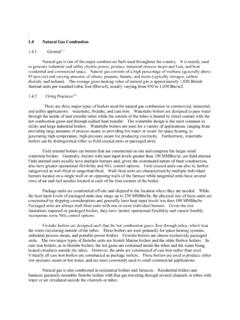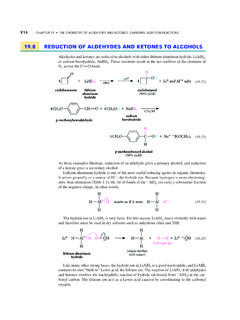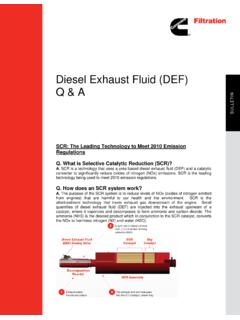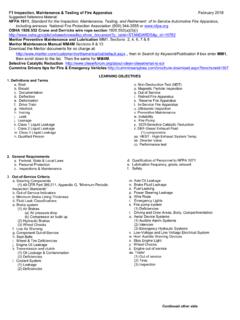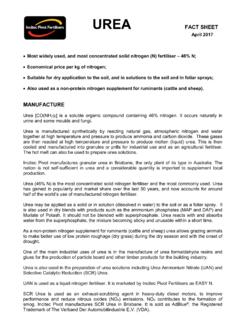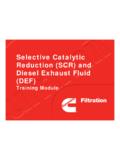Transcription of AP42 8.8 Nitric Acid Production
1 4NH3%5O264NO%6H2O02/98 Inorganic Chemical Nitric General1-2In 1991, there were approximately 65 Nitric acid (HNO) manufacturing plants in the U. S. with a3total capacity of 11 million tons of HNO per year. The plants range in size from 6,000 to 700,000 tons per3year. About 70 percent of the Nitric acid produced is consumed as an intermediate in the manufacture ofammonium nitrate (NHNO), which in turn is used in fertilizers. The majority of the Nitric acid plants are43located in agricultural regions such as the Midwest, South Central, and Gulf States because of the highdemand for fertilizer in these areas. Another 5 to 10 percent of the Nitric acid produced is used for organicoxidation in adipic acid manufacturing. Nitric acid is also used in organic oxidation to manufactureterephthalic acid and other organic compounds.
2 Explosive manufacturing utilizes Nitric acid for organicnitrations. Nitric acid nitrations are used in producing nitrobenzene, dinitrotoluenes, and other chemicalintermediates. Other end uses of Nitric acid are gold and silver separation, military munitions, steel and1brass pickling, photoengraving, and acidulation of phosphate rock. Process Description1,3-4 Nitric acid is produced by 2 methods. The first method utilizes oxidation, condensation, andabsorption to produce a weak Nitric acid . Weak Nitric acid can have concentrations ranging from 30 to 70percent Nitric acid . The second method combines dehydrating, bleaching, condensing, and absorption toproduce a high-strength Nitric acid from a weak Nitric acid . High-strength Nitric acid generally contains morethan 90 percent Nitric acid . The following text provides more specific details for each of these Weak Nitric acid Production -1,3-4 Nearly all the Nitric acid produced in the U.
3 S. is manufactured by the high-temperature catalyticoxidation of ammonia as shown schematically in Figure This process typically consists of 3 steps: (1)ammonia oxidation, (2) Nitric oxide oxidation, and (3) absorption. Each step corresponds to a distinctchemical Oxidation - First, a 1:9 ammonia/air mixture is oxidized at a temperature of 1380 to 1470EF as it passes througha catalytic convertor, according to the following reaction:(1)The most commonly used catalyst is made of 90 percent platinum and 10 percent rhodium gauze constructedfrom squares of fine wire. Under these conditions the oxidation of ammonia to Nitric oxide (NO) proceeds inan exothermic reaction with a range of 93 to 98 percent yield. Oxidation temperatures can vary from 1380 to1650EF. Higher catalyst temperatures increase reaction selectivity toward NO Production .
4 Lower catalysttemperatures tend to be more selective toward less useful products: nitrogen (N) and nitrous oxide (NO). 22 Nitric oxide is considered to be a criteria pollutant and nitrous oxide is known to be a global warming gas. The nitrogen dioxide/dimer mixture then passes through a waste heat boiler and a platinum filter.(SCC 3-01-013-02)PRODUCT(50 - 70%HNO )3 COOLERCONDENSERNO2 SECONDARY AIRPLATINUMFILTERNITROGENDIOXIDECOOLINGW ATERAIRABSORPTIONTOWERWATERENTRAINEDMIST SEPARATORNITRIC OXIDE GASFUELCOMPRESSOREXPANDERAIRTAILGASEMISS IONPOINTEFFLUENTSTACKAMMONIAVAPORNO EMISSIONSCONTROLxCATALYTIC FACTORS02/98 Figure Flow diagram of typical Nitric acid plant using single-pressure process (high-strength acid unit not shown).(Source Classification Codes in parentheses.)2NO%O262NO2XN2O43NO2%H2O62 HNO3%NO02/98 Inorganic Chemical Oxide Oxidation - The Nitric oxide formed during the ammonia oxidation must be oxidized.
5 The process stream ispassed through a cooler/condenser and cooled to 100EF or less at pressures up to 116 pounds per square inchabsolute (psia). The Nitric oxide reacts noncatalytically with residual oxygen to form nitrogen dioxide (NO)2and its liquid dimer, nitrogen tetroxide:(2)This slow, homogeneous reaction is highly temperature- and pressure-dependent. Operating at lowtemperatures and high pressures promotes maximum Production of NO within a minimum reaction time. 2 Absorption - The final step introduces the nitrogen dioxide/dimer mixture into an absorption process after beingcooled. The mixture is pumped into the bottom of the absorption tower, while liquid dinitrogen tetroxide isadded at a higher point. Deionized process water enters the top of the column. Both liquids flowcountercurrent to the nitrogen dioxide/dimer gas mixture.
6 Oxidation takes place in the free space between thetrays, while absorption occurs on the trays. The absorption trays are usually sieve or bubble cap trays. Theexothermic reaction occurs as follows:(3)A secondary air stream is introduced into the column to re-oxidize the NO that is formed in Reaction3. This secondary air also removes NO from the product acid . An aqueous solution of 55 to 65 percent2(typically) Nitric acid is withdrawn from the bottom of the tower. The acid concentration can vary from 30 to70 percent Nitric acid . The acid concentration depends upon the temperature, pressure, number of absorptionstages, and concentration of nitrogen oxides entering the are 2 basic types of systems used to produce weak Nitric acid : (1) single-stage pressureprocess, and (2) dual-stage pressure process.
7 In the past, Nitric acid plants have been operated at a singlepressure, ranging from atmospheric pressure to to 203 psia. However, since Reaction 1 is favored bylow pressures and Reactions 2 and 3 are favored by higher pressures, newer plants tend to operate a dual-stage pressure system, incorporating a compressor between the ammonia oxidizer and the condenser. Theoxidation reaction is carried out at pressures from slightly negative to about 58 psia, and the absorption reactions are carried out at 116 to 203 the dual-stage pressure system, the Nitric acid formed in the absorber (bottoms) is usually sent toan external bleacher where air is used to remove (bleach) any dissolved oxides of nitrogen. The bleachergases are then compressed and passed through the absorber. The absorber tail gas (distillate) is sent to anentrainment separator for acid mist removal.
8 Next, the tail gas is reheated in the ammonia oxidation heatexchanger to approximately 392EF. The final step expands the gas in the power-recovery turbine. Thethermal energy produced in this turbine can be used to drive the High-Strength Nitric acid Production -1,3A high-strength Nitric acid (98 to 99 percent concentration) can be obtained by concentrating theweak Nitric acid (30 to 70 percent concentration) using extractive distillation. The weak Nitric acid cannot beconcentrated by simple fractional distillation. The distillation must be carried out in the presence of adehydrating agent. Concentrated sulfuric acid (typically 60 percent sulfuric acid ) is most commonly used forthis purpose. The Nitric acid concentration process consists of feeding strong sulfuric acid and 55 to 65percent Nitric acid to the top of a packed dehydrating column at approximately atmospheric pressure.
9 Theacid mixture flows downward, countercurrent to ascending vapors. Concentrated Nitric acid leaves the top ofthe column as 99 percent vapor, containing a small amount of NO and oxygen (O) resulting from22dissociation of Nitric acid . The concentrated acid vapor leaves the column and goes to a bleacher and acountercurrent condenser system to effect the condensation of strong Nitric acid and the separation of oxygenWEAKNITRIC ACIDABSORPTIONCOLUMNINERT,UNREACTEDGASES AIRO , NO2 STRONGNITRIC ACIDCONDENSERCOOLINGWATERBLEACHERHNO , NO , O322 DEHYDRATINGCOLUMN50-70%HNO3H FACTORS02/98 Figure Flow diagram of high-strength Nitric acid Production from weak Nitric oxides of nitrogen (NO) byproducts. These byproducts then flow to an absorption column where thexnitric oxide mixes with auxiliary air to form NO, which is recovered as weak Nitric acid .
10 Inert and unreacted2gases are vented to the atmosphere from the top of the absorption column. Emissions from this process arerelatively minor. A small absorber can be used to recover NO. Figure presents a flow diagram of2high-strength Nitric acid Production from weak Nitric Emissions And Controls3-5 Emissions from Nitric acid manufacture consist primarily of NO, NO (which account for visible2emissions), trace amounts of HNO mist, and ammonia (NH). By far, the major source of nitrogen oxides33(NO) is the tailgas from the acid absorption tower. In general, the quantity of NO emissions is directlyxxrelated to the kinetics of the Nitric acid formation reaction and absorption tower design. NO emissions canxincrease when there is (1) insufficient air supply to the oxidizer and absorber, (2) low pressure, especially inthe absorber, (3) high temperatures in the cooler-condenser and absorber, (4) Production of an excessivelyhigh-strength product acid , (5) operation at high throughput rates, and (6) faulty equipment such ascompressors or pumps that lead to lower pressures and leaks, and decrease plant 2 most common techniques used to control absorption tower tail gas emissions are extendedabsorption and catalytic reduction .










